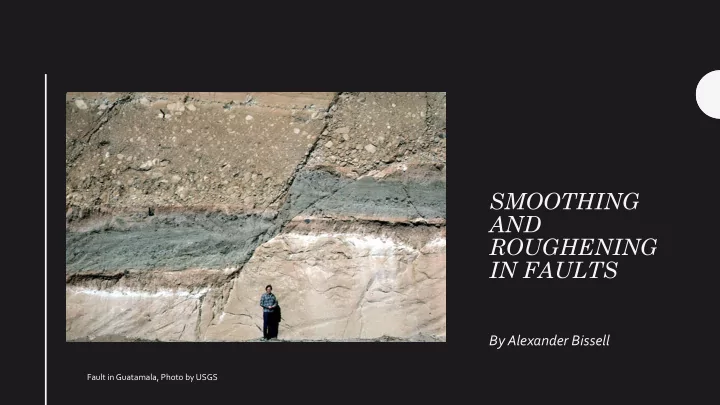

SMOOTHING AND ROUGHENING IN FAULTS By Alexander Bissell Fault in Guatamala, Photo by USGS
• The geometric properties of a fault zone have major effects on earthquake rupture STUDY processes OVERVIEW • Characterizes a single, exposed fault zone via photogrammetry • Smoothing and re-roughening processes are approx. balanced
Geologic Setting • La Quinta Fault in Coyote Canyon, So. Cal. • biotite-hornblende rich tonalite containing a weak regional foliation A: Hydraulic Pump B: Computer to collect data C: Loading frame D: Loading frame control
Outcrop Info • Surfaces of older faults are smoother than younger, and in the slip-parallel direction • Fault contains multiple generations of slip events • Measured roughness of slip surface on the centimeter to 10 meter scale • Apparent equilibrium between the various roughening and smoothing regimes
Processes • At the micro scale, grain plucking between layers acted to re-roughen by creating embayments • Repeated grain plucking smooths at scales larger than grain size • Clasts formed within inner fault core originate from sheared asperites, a smoothing event. • Fracture surfaces around these clasts are rougher than surrounding rock
Methods – Fault outcrop mapped using photogrammetry – 150 photos taken of a highly exposed (56.5%) fault – External structure mapped using Structure from Motion technique – Internal structure measured in the field using standard stereo-net methods a) Photograph of the fault. b)Computer generated 3D model c)Rectified texture of the fault after 3D generation. Blue = inner fault, green = outer fault
Photogrammetry Overview • Dozens to hundreds of photos are taken from varying angles in a consistent light (i.e. an overcast day, around noon) • The program maps out a point cloud using the subtle shifts in shadows and edges from the movement of the camera • This point cloud is used to generate polygons, and a texture from the photos is applied Model by Alexander Bissell using Agisoft PhotoScan
Rectifying Pictures • Photos are rectified against one another, as well as against GPS data • Manual Tie-In points can be added to increase accuracy • Using the GPS and compass in the phone, EXIF data from each photo is used to geo-rectify the outcrop • In the original study, ground control points and reference markers were used.
Model Accuracy • Resolution of 1.2 mm/pixel • Generated model will vary slightly each time it is generated • Sub-cm accuracy is easily obtained • Sub-mm accuracy requires more precise techniques ($$$)
Future – Use a Scanning Electron Microscope (SEM) to image on the grain scale studies – Do topological analysis to find out neat things (i.e. moment of inertia) – 3D print subsequent model for educational purposes – Impress your friends and colleagues with hand specimens of fly ash
Questions? (also seriously lets scan some microscopic stuff)
Recommend
More recommend